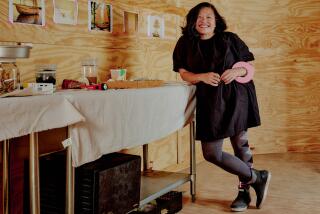John van Hengel, 83; Set Up 1st Food Bank
- Share via
John van Hengel, who founded what is widely regarded as the nation’s first food bank in an abandoned Phoenix bakery in 1967 and helped cities around the world set up similar systems to feed the poor, has died. He was 83.
Van Hengel, who had Parkinson’s disease and had suffered several strokes, died Wednesday in a Phoenix hospice care facility, according to an announcement from America’s Second Harvest, a national hunger-relief organization that grew out of his efforts.
“We have lost a true American hero,” Robert Forney, president of America’s Second Harvest, said in a statement. “He created food banks because he realized that millions of pounds of nutritious food were being wasted at the same time that millions of Americans were going hungry.”
The idea for creating a clearinghouse for unwanted food from grocery stores struck Van Hengel when a social worker introduced him to a mother of 10 whose husband was on death row.
Feeding her children was no problem because she shopped daily in refuse bins in back of a grocery store, she had said.
When Van Hengel checked the bins, he found food that was frozen but still edible, loose vegetables and stale bread. Inside the store, he found less-perishable castoffs, such as dented cans and bags leaking rice and sugar.
Within a year, a bakery near skid row that had been willed to St. Mary’s Church became a place where trucks from several Arizona cities brought food that grocery companies could not sell.
That first year, 250,000 pounds of food was distributed to 36 charities. During the year ending in June, St. Mary’s had distributed about 60 million pounds of food to 900 agencies.
The term “food bank” was coined when a grandmother, who was one of Van Hengel’s initial helpers, drew a cartoon of a building with food being deposited and happy faces making withdrawals. She said they had built a bank of food.
“I said, ‘That’s it. We’ll call this place St. Mary’s Food Bank,’ ” Van Hengel told The Times in 1992.
St. Mary’s inspired the Grandview Food Bank of Pasadena, the nation’s second food bank, and others in San Diego, San Jose and Concord, Calif.
“John changed the world. He created this wonderful, simple, brilliant concept of food banking, and he has touched millions,” Terry Shannon, director of the Phoenix food bank that Van Hengel founded, told the Arizona Republic.
In 1976, Van Hengel left to found America’s Second Harvest, the nation’s largest charitable hunger-relief organization -- with more than 200 member food banks and more than 50,000 agencies -- that feeds 23 million people a year.
He stayed with the organization until 1983 and traveled the world to teach other countries how to set up food banks.
In California, 19 food banks belong to the Second Harvest network. Among them is the Los Angeles Regional Food Bank, which moved 45 million pounds of food last year, for about 36 million meals, said Darren Hoffman, communications manager.
Begun in Phoenix with a $50,000 federal grant, Second Harvest counseled cities that wanted to follow Van Hengel’s lead. It also sought out unwanted food from manufacturers, such as 37 railroad cars of cereal with too many raisins.
The U.S. Department of Agriculture estimates that about 10% of Americans rely on the nonprofit distribution chain for their food.
“It’s amazing how many people are being fed because of this crazy little thing we started,” Van Hengel told The Times. “But it scares me to look back, because I just had no idea it would grow into this.”
Van Hengel grew up in Waupun, Wis., the son of a nurse and the town pharmacist. After graduating from Lawrence University in Appleton, Wis., in 1944 with a degree in government, he moved to Southern California.
After spending time as “a first-rate beach bum,” he studied broadcasting at UCLA and later took a series of jobs, including garment industry ad man, driver of a beer truck in Beverly Hills and sales manager for Bear Archery.
He married a model for the I. Magnin department stores, had two sons and started drifting after a bitter divorce in 1960.
“I took off back to Wisconsin, hurt, escaping and so angry that I wanted the worst job I could find,” Van Hengel once said.
Back-breaking work at a rock quarry in Wisconsin came with a rough crowd. During a fight after work, Van Hengel’s spine was injured, leaving him partially paralyzed. His doctor said the dry weather in Phoenix might help him, so Van Hengel moved there.
A lifelong Roman Catholic, Van Hengel soon realized he wanted to be involved in charity work and began by recovering collection cans from grocery stores. His salary was 30% of the loose change.
He bought an old milk delivery truck for $150 and used it to deliver to charities the fruit he picked from homeowners’ trees. When he needed a central location to store the fruit, he opened a free fruit store in the old bakery, setting the stage for the food bank.
During his first decade at St. Mary’s, he took no salary. He wore secondhand clothes, got his groceries at the food bank and lived in a donated room above a garage.
Shy, retiring and humble, Van Hengel was dubbed “the Mother Teresa of celery,” a title of which he was most proud.
Van Hengel is survived by two sons, Thomas, of Scottsdale, Ariz., and John, of Kansas City, Kan.
More to Read
Eat your way across L.A.
Get our weekly Tasting Notes newsletter for reviews, news and more.
You may occasionally receive promotional content from the Los Angeles Times.











